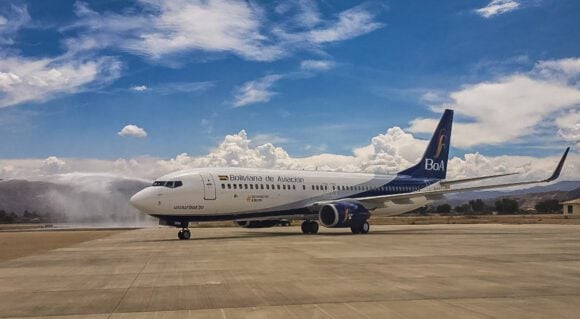
SWISS Boeing777 Copyright SWISS
PR: Over the past 18 months, SWISS has equipped its Boeing 777-300ER fleet with sharkskin technology from Lufthansa Technik and BASF. The AeroSHARK surface film mimics a sharkskin’s flow-optimizing characteristics. Applied to the fuselage and engine nacelles, it reduces drag during flight, promoting lower fuel consumption and CO2 emissions. All twelve modified 777 aircraft have been in service with SWISS this month.

This is the first time an entire airline’s Boeing long-haul fleet has been optimized with the new technology.
Swiss International Air Lines fitted all of its 777-300ER aircraft with this fuel-saving technology after the world’s first AeroSHARK scheduled flight in October 2022.
AeroSHARK recreates sharkskin’s drag-reducing features. Thanks to its surface structure, which consists of about 50 micrometers of fine riblets, the aircraft’s aerodynamics are optimized, and the drag is reduced by about one percent. Therefore, less fuel is burned, reducing emissions.

With its gradually upgraded fleet, SWISS saved over 2,200 tons of JetA and around 7,100 metric tons of CO2 in 2023. The last remaining aircraft (HB-JNF) was fitted with AeroSHARK at the beginning of May 2024, and all Boeing 777s are now modified with this innovative technology.
“We are very pleased with the results that we have achieved with AeroSHARK to date,” says Claus Bauer, SWISS’s Head of Technical Fleet Management. “We’re proud too, to be the first airline in the world to have equipped an entire aircraft fleet with this innovative technology. Each aircraft takes about a week to have its AeroSHARK film applied, which requires high-precision workmanship from our personnel. I am delighted that our commitment to this technology is delivering such positive results and is enabling us at SWISS to take a further substantial step in making our flight operations more sustainable.”
Reducing emissions with innovations
“Equipping the entire SWISS Boeing 777 fleet with AeroSHARK marks a milestone on the way to lower emissions in aviation. Even supposedly small technical innovations can make an important contribution to reducing CO2; emissions when flying,” states Sören Stark, CEO of Lufthansa Technik. “The fuel-saving effect of the bionic film has been confirmed in more than 60,000 flight hours at SWISS alone. This is the result of hard work, intensive research and a strong partnership between Lufthansa Technik and BASF. We are proud of this and want to continue to play an active role in shaping the transformation of aviation.”
The implementation of AeroSHARK was preceded by years of research and development work by Lufthansa Technik and BASF.
At the end of 2022, the European Aviation Safety Agency (EASA) granted Lufthansa Technik approval for the series conversion of two Boeing 777 aircraft types with AeroSHARK after an extensive examination process. A total of 17 Lufthansa Group aircraft have been modified with AeroSHARK, and the number is growing. Lufthansa Technik and BASF intend to continue developing AeroSHARK for other aircraft types and larger areas to support airlines worldwide in achieving their emission targets.
This type of smart technology helps commercial aviation move towards a cleaner future. Sure, Net Zero is an important and useful goal, but the path to reach this requires many steps and a lot of creativity.
The AeroSHARK idea is a significant step forward. The solution generates ~1% better fuel burn with a very low weight impact. The chart provides an idea of the impact. The chart shows 777-300ER fuel burn.

What does that 1% mean? AroSHARK appears to save 28 gallons of fuel per flight hour. Since these aircraft routinely do 12-hour flights, that means 336 gallons of fuel per leg. Another 336 gallons are saved on the return leg. Nearly 700 gallons of JetA are saved on a routine round trip. Over a year, Swiss could save over 240,000 gallons of JetA per aircraft—all twelve should save the airline nearly 3 million gallons of JetA per year.
There is a cash saving – about $7m per year. Savings are most welcome for a European airline with high fuel taxes. However, Swiss has demonstrated it is moving towards greener operations by making a small tweak with a big impact. Expect this move to be copied.
Views: 11




